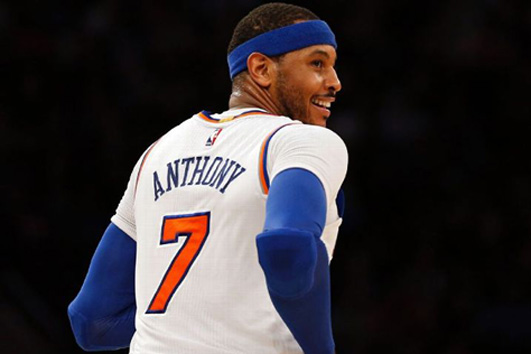
[av_one_full first min_height=” vertical_alignment=” space=” custom_margin=” margin=’0px’ padding=’0px’ border=” border_color=” radius=’0px’ background_color=” src=” background_position=’top left’ background_repeat=’no-repeat’ animation=”]
[av_heading heading=’Melo escapes New York, leaves behind mixed legacy’ tag=’h3′ style=’blockquote modern-quote’ size=’30’ subheading_active=’subheading_below’ subheading_size=’15’ padding=’10’ color=” custom_font=”][/av_heading]
[av_image src=’http://www.panaynews.net/wp-content/uploads/2017/09/sports-melo.jpg’ attachment=’118599′ attachment_size=’full’ align=’center’ styling=” hover=” link=” target=” caption=” font_size=” appearance=” overlay_opacity=’0.4′ overlay_color=’#000000′ overlay_text_color=’#ffffff’ animation=’no-animation’][/av_image]
[av_textblock size=” font_color=” color=”]
A FEW WEEKS into the 2014-15 season, a handwritten message appeared on the whiteboard in the New York Knicks’ locker room.
“The pain that you have been feeling can’t compare to the joy that’s coming … Romans 8:18.”
The message was designed to give hope to a Knicks team in the opening stages of a free fall, but the words take on a new meaning now for Carmelo Anthony as he heads to the Oklahoma City Thunder for Enes Kanter, Doug McDermott and a 2018 second-rounder.
It’s a transaction that shakes up the NBA and makes a Western Conference power even more dangerous. It was eerily similar in scope to the three-team, 12-player trade that sent Anthony to New York seven years ago. In many ways, Anthony’s legacy as a Knick can be summed up in the same way you’d describe these two trades: extremely complicated.
Early in the 2014-15 season – a few months after Anthony signed a $124 million deal to remain with the New York Knicks – he was already having second thoughts about his decision.
After one vexing home loss, Anthony shared his frustration with a few friends at the arena. One friend summed up Anthony’s mindset at the time: “He said he should’ve signed with Chicago.”
It wasn’t the last time Anthony questioned his decision to re-sign with the Knicks. Over the next three seasons, it became clear that Anthony and New York, under team president Phil Jackson, were stuck in one of the NBA’s most dysfunctional relationships.
So now that it’s over, how do you unpack Anthony’s time with the Knicks?
Some will remember him as a ball-stopper whose preferred style of play ultimately impeded the Knicks’ ability to win. There’s merit to that theory.
Others will hang on to the idea that Anthony never had a chance to truly succeed in New York because of the Knicks’ perpetual roster and coaching instability. There’s plenty to support that point as well. As is usually the case, the truth probably lies somewhere in between.
The raw results during Anthony’s Knicks tenure aren’t pretty. New York never advanced past the second round of the playoffs, and the club missed the postseason entirely in each of the past four years. The Knicks finished 207-269 during Anthony’s six full seasons and went 1-3 in playoff series.
But how much of that was Anthony’s fault?
His six-plus seasons in New York were filled with constant turnover. A half-dozen executives and coaches were hired and fired during Anthony’s tenure. He had 72 different teammates in his past six seasons. That’s the sixth-highest total in the NBA in that span and 10 more players than the NBA average.
“I’ve had nightmares about that,” Anthony said late last season.
If you want to start a fun argument among Knicks fans, ask them who Anthony’s most talented Knicks teammate was. Was it Amar’e Stoudemire? Kristaps Porzingis? Tyson Chandler? A 40-year-old Jason Kidd?
Of course, Anthony’s detractors will point to his isolation-heavy style of play as a reason for the revolving door of executives, coaches and players.
People around the Knicks will always question whether Anthony did enough with the hand he was dealt.
To most close observers, the beginning of the end for Anthony was March 12.
Knicks coach Jeff Hornacek lit into the team at halftime of a game that day against the Brooklyn Nets. While Hornacek unloaded in an expletive-filled critique, Anthony sat in the corner.
Coaches giving R-rated critiques of their teams’ play at halftime isn’t unusual. But something extraordinary happened that afternoon.
The normally laid-back Anthony – his preferred social media hashtag is #StayMe7o – was moved to respond. And it wasn’t pretty.
According to people familiar with the matter, Anthony said to no one in particular that “this whole thing” is a “joke” and added “f— this place” loud enough for most in the room to hear. Associate head coach Kurt Rambis responded to Anthony directly, asking him if he had anything to say to the group.
“Yeah I have something to say: This place is a f—ing joke,” Anthony responded.
Rambis, using the same expletive-laden phrase, then questioned Anthony’s effort. Things didn’t escalate from there, but it was clear to most around the team that Anthony was done with the Knicks. (ESPN)
[/av_textblock]
[/av_one_full]



